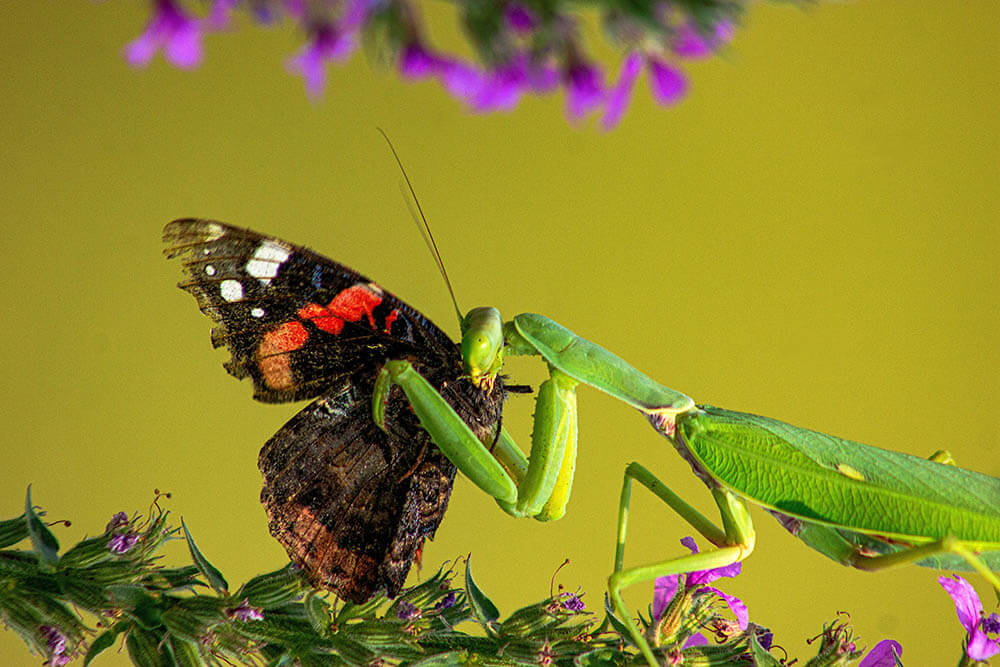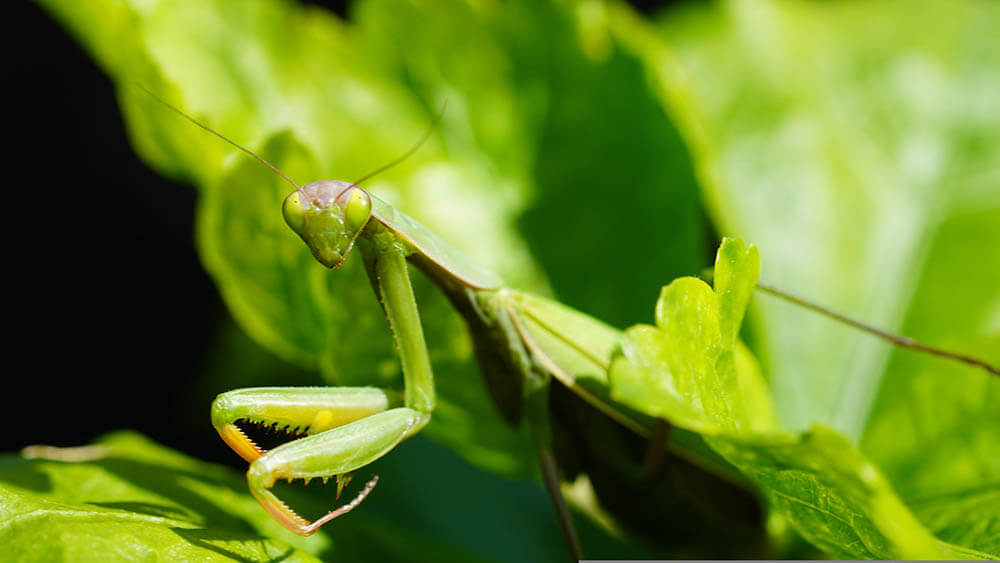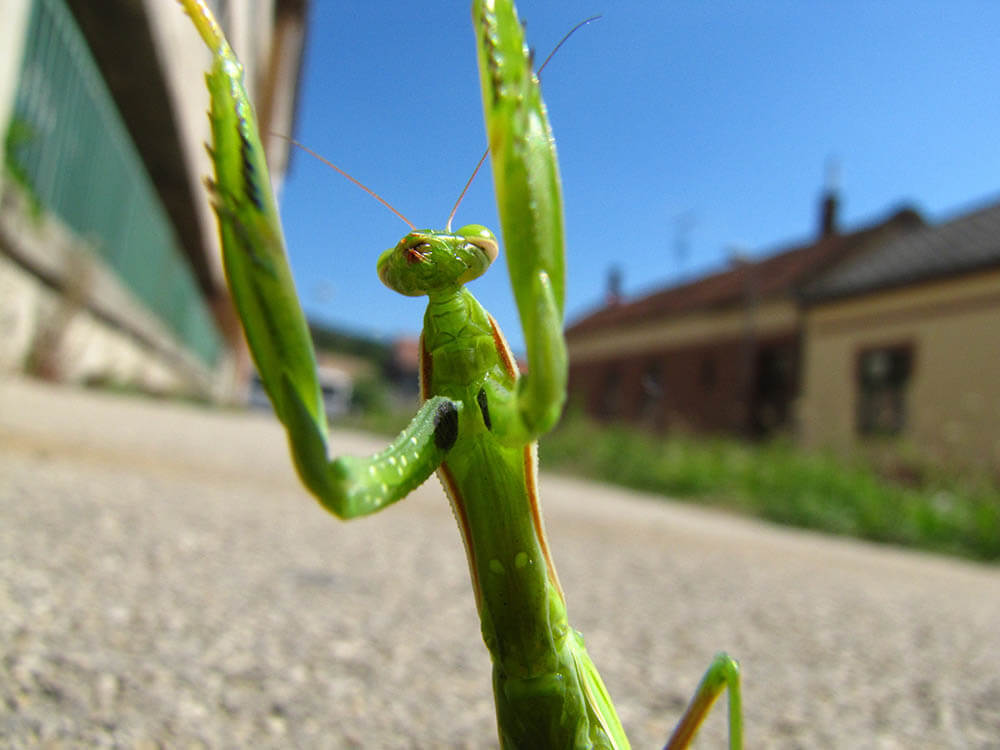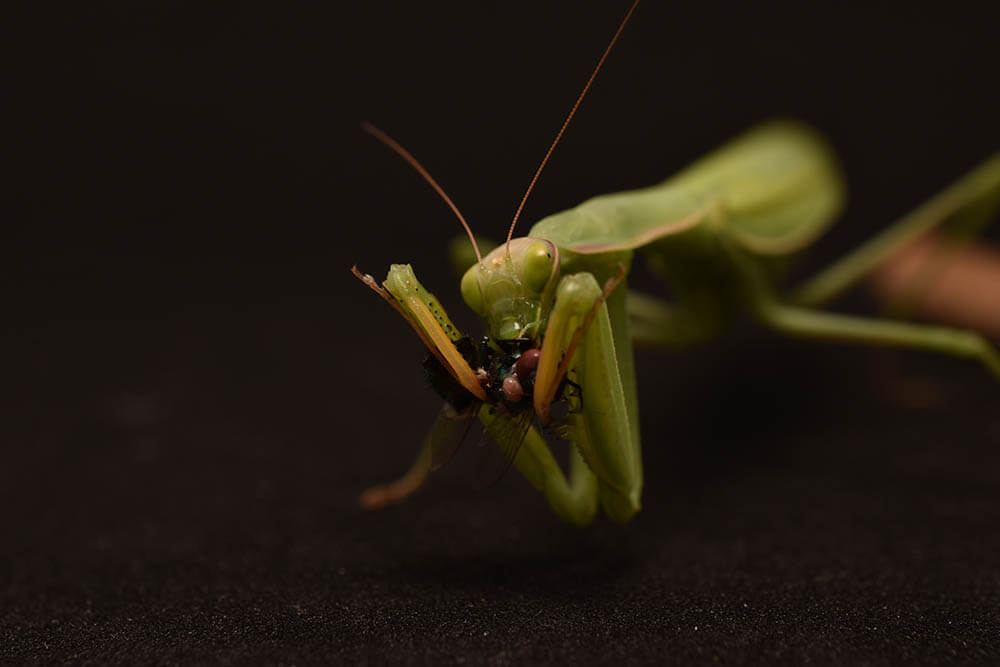If you’re familiar with what a praying mantis is, then you likely already know what a voracious little monster this creature is.
But what do voracious little monsters eat? What, exactly, is on the praying mantis’ menu? And would this creature’s diet change depending on whether it’s living in its natural habitat or a terrarium in someone’s home?
Before we discuss what the praying mantis eats both in the wild and in captivity, let’s take some time to get to know this ferocious insect just a little better, shall we?

What Is a Praying Mantis?
The praying mantis (scientific name: Mantis religiosa) is a large insect in the order Mantodea. It boasts extremely long front legs known as raptorial legs, which it positions in a manner that makes it look like it’s praying – thus the name “praying mantis.”
This creature has a triangular head with enormous, compound eyes, a long body, and two pairs of wings. The female is larger and heavier than the male, though the male has larger antennae and eyes. Because the male is smaller, it’s far more agile than the female. While the female is more powerful, it can’t fly.
Approximately 2,000 praying mantis species can be found all over the world, though most live in tropical and subtropical regions. They come in various shapes, sizes, and colors.
Their color influences their choice of habitat. Green mantises, for example, prefer staying among spring trees and green grass. On the other hand, brown mantises are drawn to dead leaves and brown grass. This allows them to blend in with their environment, in turn protecting them from predation by birds and other insect-eating animals.
The female praying mantis lays around 200 eggs in a big, cocoon-like capsule. This protects said eggs from inclement weather and predators. Baby praying mantises, known as nymphs, hatch simultaneously, emerging from their eggs looking like miniature versions of the insect. Nymphs are typically cannibalistic.
Speaking of cannibalism, it’s time to dive into what these fearsome bugs like chowing down on!

The Wild Praying Mantis’ Diet
Wild praying mantises are aggressive ambush predators that viciously attack and consume a wide range of insects. They’re also known to eat spiders.
Below are some of the creatures praying mantises usually dine on:
- Ants
- Aphids
- Bees
- Beetles
- Butterflies
- Caterpillars
- Cicadas
- Cockroaches
- Crane flies
- Crickets
- Dragonflies
- Flies
- Gnats
- Grasshoppers
- Locusts
- Mealworms
- Mosquitoes
- Moths
- Spiders
The bigger the praying mantis species, the bigger the prey it can catch and consume. Some larger species, for example, can eat tarantulas.
Larger species are also known to devour small lizards, amphibians (such as frogs), birds (especially hummingbirds), rodents (e.g. mice), and even fish (e.g. guppies).
And of course, we can’t discuss the praying mantis’ diet without going into detail about its infamous sexual behavior. Which brings us to…
Praying mantis cannibalism
Praying mantises eat other praying mantises during sexual encounters… and it’s often the female that does the cannibalizing.
Yes, sexual cannibalism is a thing among praying mantises. Sexually mature male mantises know how dangerous sex is for their species, so when one finds a sexually mature female he wants to mate with, he approaches her with extreme caution.
A male will slowly approach a female from behind, halting any moment she makes sudden movements. Once he’s close enough to her, he’ll leap onto her back and wrap his legs around her for a firm grip. When his position is secure, he’ll start copulating with her. Copulation can take between four and five hours. After copulation, the male releases the female and quickly flees lest he becomes lunch.
The female can attack and feed on the male at any time during this process, so a male can find himself being devoured even during sex!
But why would a female praying mantis engage in sexual cannibalism? Simple: male praying mantises are nutrient-rich edibles, so ingesting one means the female won’t have to look for food after copulation. The meal also provides her with additional resources necessary for the production of large, high-quality eggs, which in turn increases her offspring’s chances of surviving.
While females are usually the aggressors, males may sometimes initiate the violence. A male could, for example, attack, wrestle with, and pin down the female so that he can mate with her without being eaten. This can lead to severe injuries in the female. If the female wins this struggle, however, the male typically ends up in her belly.

The Pet Praying Mantis’ Diet
Yes, praying mantises can be kept as pets. As lethal as they are where other bugs are concerned, they’re generally harmless to humans. Some are even quite docile!
If you’re considering getting a pet praying mantis, know that its diet should be a close replication of what a wild praying mantis eats. This means you should feed your pet several of the insects mentioned in the previous section.
However, we don’t recommend catching prey from the wild and giving them to your pet. This is because wild animals may be carrying diseases that they can pass on to a praying mantis when it eats them. Some of these creatures may also be contaminated with potentially harmful chemicals such as pesticides.
The best thing to do is to purchase your praying mantis’ food from reputable exotic pet stores and bait shops. Many of these establishments offer live and dried mealworms, crickets, moths, and other organisms your pet can ingest. You can even grow these insects at home so your pet has a steady supply of food.
Generally speaking, it’s best to feed your praying mantis gut-loaded food. These are critters that have been fed diets rich in nutrients. When your pet consumes these creatures, it absorbs said nutrients, thus allowing it to enjoy the excellent health it requires to live a long, happy life.
Depending on your pet’s species and size, it will eat every 1 to 4 days. Place around 1 to 2 insects, such as crickets or flies, in its terrarium daily. If any of these insects remain uneaten after 1 hour, remove them from the terrarium.
With that said, here are a few more tips on how to feed your pet praying mantis properly!
Provide your praying mantis with appropriately sized prey
As previously discussed, the size of a praying mantis determines the size of its prey. Because a young praying mantis is small, feed it tiny insects such as fruit flies and/or aphids.
As your pet grows older and larger, you can start giving it larger insects such as cockroaches, crickets, flies, and grasshoppers. Live insects should be smaller than your praying mantis. Insects that are much larger than it should be offered dead. Otherwise, they could attack and overpower your pet, possibly resulting in severe injuries or even death.
Help your praying mantis out
In general, praying mantises prefer their food alive and kicking. To prevent your pet’s food from escaping, use tweezers or forceps to grip it on one end, a leg, or its tail. This grip must be firm, but not strong enough to crush or kill the animal.
You should then deposit the food in your pet’s terrarium. Your pet will hunt these critters down, which means it gets to enjoy not only a savory meal but also the physical activity it requires to remain in great health. You can stay and watch to ensure your pet successfully catches its meal.
Alternatively, you can use tweezers to directly introduce the prey to your praying mantis. Essentially, you have to bring the food close enough to your pet that it can snatch it from the tweezers and start munching on it. This method can ensure the food doesn’t escape or attack your pet to cause injury.
Don’t disturb a molting praying mantis
Praying mantises tend to refrain from eating a few days before they begin molting. Thus, if your praying mantis refuses to eat, it might be preparing to molt.
Because these insects are in an extremely delicate state during molting, don’t disturb your pet while it’s in this stage. In other words, don’t offer a molting praying mantis any living insects, and remove all uneaten food from its enclosure.
If your praying mantis isn’t ready to molt yet leaves all its food uneaten, seek veterinary advice. A lack or loss of appetite can mean your pet is ill, so having a vet treat any health problems can help restore it to its usual ravenous self. A vet can also give you good advice regarding how to improve your pet’s enclosure so that it feels comfortable enough to eat.
Consider keeping male and female praying mantises apart
Like we talked about earlier, female praying mantises engage in sexual cannibalism. For this reason, it might be a good idea to separate your male and female praying mantises. Otherwise, the female could end up killing and eating the male.

Conclusion
Praying mantises feed on a rich variety of food. Though they focus primarily on insects smaller than them, they also eat arachnids, amphibians, lizards, birds, rodents, and fish. And the larger the praying mantis, the larger the prey it can kill and consume, with some preying on enormous spiders such as tarantulas.
A praying mantis in captivity requires a diet that closely resembles its natural one. Thankfully, you can buy lots of insects from reputable exotic pet stores and bait shops. Avoid catching wild prey for your pet, as these can be contaminated with diseases and chemicals that can cause praying mantises harm.
Make sure you take all necessary steps to feed your praying mantis properly. Don’t forget to ask a vet for help if your pet won’t eat its food!
